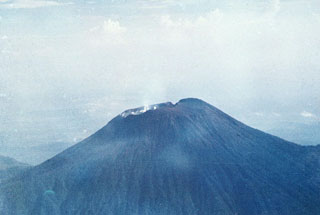Report on Slamet (Indonesia) — April 2008
Bulletin of the Global Volcanism Network, vol. 33, no. 4 (April 2008)
Managing Editor: Richard Wunderman.
Slamet (Indonesia) Heavy rains trigger steam plumes during 28 March-3 April 2007
Please cite this report as:
Global Volcanism Program, 2008. Report on Slamet (Indonesia) (Wunderman, R., ed.). Bulletin of the Global Volcanism Network, 33:4. Smithsonian Institution. https://doi.org/10.5479/si.GVP.BGVN200804-263180
Slamet
Indonesia
7.242°S, 109.208°E; summit elev. 3428 m
All times are local (unless otherwise noted)
Our last review of Slamet's activity was in November 2000, reporting a white, gas-rich plume from the stratovolcano (BGVN 25:11). We are unaware of subsequent reporting until 28 March 2007. Starting that day and through 3 April, a volcano observer reported that plumes had increased in intensity and frequency. This 7-day interval took place after two weeks of heavy rains. The plumes were of sufficient magnitude to be visible in the provincial capital, Semarang, over 138 km to the ENE. The plumes did not significantly impact residents in vicinity of the volcano. Thermal anomalies (MODVOLC) have been absent on the upper cone during 2000 through 5 June 2008.
Geological Summary. Slamet is one of Java's most active volcanoes. It has a cluster of about three dozen cinder cones on its lower SE-NE flanks and a single cinder cone on the W flank. It is composed of two overlapping edifices, an older basaltic andesite to andesitic volcano on the west and a younger basaltic to basaltic andesite one on the east. Gunung Malang II cinder cone on the upper E flank on the younger edifice fed a lava flow that extends 6 km E. Four craters occur at the summit of Gunung Slamet, with activity migrating to the SW over time. Eruptions recorded since the 18th century have originated from a 150-m-deep, 450-m-wide, steep-walled crater at the western part of the summit and have consisted of explosive eruptions generally lasting a few days to a few weeks.
Information Contacts: Dali Ahmad, Center of Volcanology and Geological Hazard Mitigation, Saut Simatupang, 57, Bandung 40122, Indonesia (URL: http://vsi.esdm.go.id/); Hawai'i Institute of Geophysics and Planetology (HIGP) Thermal Alerts System, School of Ocean and Earth Science and Technology (SOEST), Univ. of Hawai'i, 2525 Correa Road, Honolulu, HI 96822, USA (URL: http://modis.higp.hawaii.edu/).

